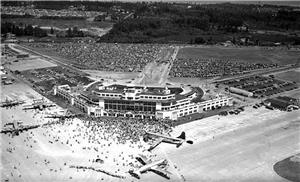On September 15, 1944, the Port of Seattle Commission votes to rename the new Seattle-Tacoma Airport “Johnson Field” in honor of Philip G. Johnson (1891-1944), Boeing’s wartime president, who died the previous day. Tacoma officials quickly block the plan and the name-change is cancelled.
Phil Johnson was a popular and energetic executive who joined Boeing in 1919 and rose to become president of the company’s United Aircraft and Transport conglomerate. When federal regulators forced UAT’s dissolution in 1934, Johnson departed for Canada where he organized and led the government's Trans-Canada Airlines. He was called back to Seattle after Pearl Harbor to lead Boeing’s war production effort. Johnson died of a sudden brain hemorrhage while visiting Wichita, Kansas, on September 14, 1944.
Naming Rights & Wrongs
In 1942, Tacoma’s Port Commission, city government, and Pierce County lobbied for selection of Bow Lake for a new regional airport and pledged $100,000 towards construction costs (which topped $4 million by 1944) in exchange for sharing the facility's name with Seattle. They objected immediately and loudly to the new name, and Seattle’s Port Commission reversed itself on September 21, 1944, settling for a memorial plaque to honor Johnson. Sea-Tac was completed the following month and civilian operations began in 1946. The Port added "International" to the airport's name in 1949 when it dedicated a modernistic control center and terminal.
The "name game" scenario was replayed 39 years later when the Port of Seattle proposed to rename Seattle-Tacoma International Airport to honor U.S. Senator Henry M. Jackson, who died on September 1, 1983, in his Everett home. Again, Tacoma’s opposition led the Port to reconsider.

